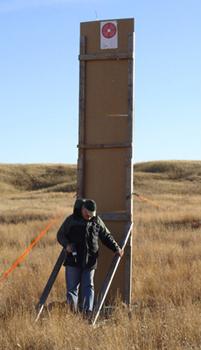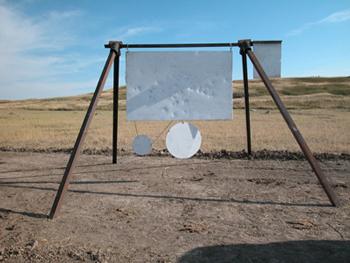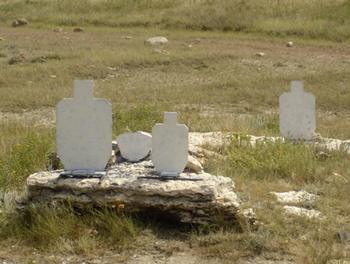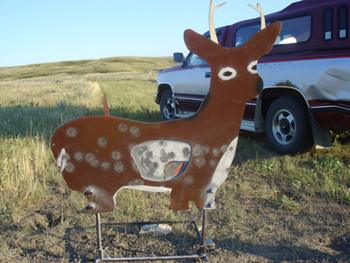Long Range Targets
By Ian McMurchy
[floatright]
 [/floatright]Far across the huge valley a tiny vertical white object looked out of place in the green vegetation. Although our target frame was over fifteen feet tall and four feet wide at seven hundred yards it was small – very small. Invisible to the naked eye are two six-inch round ShootNSee targets positioned at the top of the target paper. These are our aiming points for an interesting exercise as we determine our long-range bullet drops.
[/floatright]Far across the huge valley a tiny vertical white object looked out of place in the green vegetation. Although our target frame was over fifteen feet tall and four feet wide at seven hundred yards it was small – very small. Invisible to the naked eye are two six-inch round ShootNSee targets positioned at the top of the target paper. These are our aiming points for an interesting exercise as we determine our long-range bullet drops.
Essentially we start at 100 yards and maintain the same point of aim each time we move farther out. We fire groups at 100, 200, 300, 350, 375, 400, 425, 450, 475, 500, 525, 550, 575, 600, 625, 650, 675 and 700 yards. By always aiming at the original aiming point gravity pulls the bullets down the large cardboard sheets that are stapled to the front of the target frame. This is a time-consuming process since we have to relocate our firing position seventeen times. I believe that it gives us the best drop info for our long range hunting.
The stand is built of eight foot two-by-four boards. My partner designed it to be somewhat portable. The entire frame collapses so we can transport it in our trucks. When we take the big frame out to our long-range shooting spot we drag it with ropes like a toboggan. We use an electric screw-driver and long wood-screws to assemble the frame, then staple large sheets of heavy cardboard for a facing. Since the target frame is so tall we must brace it against the constant prairie
winds. We pound steel pegs into the ground and use nylon straps to keep the frame from blowing over. We also place large boulders on the base-boards to hold the frame in place. Although we have shot in some ugly winds the big frame has never toppled – so far.
We start our shooting at one hundred yards shooting prone with the rifle supported by a Harris bipod and a beenie bag at the butt. We usually fire three-shot groups. Sometimes we will go with five-shot groups but we find that three good shots will do the job.
[floatleft]
 [/floatleft]We have three other styles of long range targets. First is the large steel hanging plate. We suspend a four foot by two foot sheet of 3/8ths or 1/2 inch steel plate from chains attached to an old swing-set. We spray-paint the plate white and only shoot at it at 600 yards or longer. The large size ensures that we will hit somewhere on the plate. We make corrections from the first hits to move the point of impact to the point of aim. Bullet splats can be seen out to 1000 yards easily and hits can be heard as a “gonnng” from that distance.
[/floatleft]We have three other styles of long range targets. First is the large steel hanging plate. We suspend a four foot by two foot sheet of 3/8ths or 1/2 inch steel plate from chains attached to an old swing-set. We spray-paint the plate white and only shoot at it at 600 yards or longer. The large size ensures that we will hit somewhere on the plate. We make corrections from the first hits to move the point of impact to the point of aim. Bullet splats can be seen out to 1000 yards easily and hits can be heard as a “gonnng” from that distance.
Our second steel target is smaller and designed to fall over when hit. We simply weld an inverted “T” base onto 12 to 15 inch squares of 1/2 inch steel plate. We use two 12 inch pieced of t-bar to make the base. The target is then sprayed white and setup at whatever distance we wish to practice. We recently dropped the size of this target down to six by six inches for more challenge. These targets fall backward when hit and the bullet makes a good ringing sound.
[floatright]
 [/floatright]Our third target is a commercial design from LV Steel Targets in Las Vegas, Nevada. These targets swing backwards when hit, then return to the vertical position. There is also an excellent sound when they are hit. We use the LV’s from 350 yards out. They are so hard that the bullet merely blows the paint away forming a nice visible splat. I have two sizes of LV targets; the smaller target is very challenging at 700 yards. We use the larger target at long distance and also to help catch hits at closer range in high winds. Check out www.lvsteeltargets.com to see all the sizes and shapes available. These targets are very well made and reasonably priced. They are adjustable for various impact energies.
[/floatright]Our third target is a commercial design from LV Steel Targets in Las Vegas, Nevada. These targets swing backwards when hit, then return to the vertical position. There is also an excellent sound when they are hit. We use the LV’s from 350 yards out. They are so hard that the bullet merely blows the paint away forming a nice visible splat. I have two sizes of LV targets; the smaller target is very challenging at 700 yards. We use the larger target at long distance and also to help catch hits at closer range in high winds. Check out www.lvsteeltargets.com to see all the sizes and shapes available. These targets are very well made and reasonably priced. They are adjustable for various impact energies.
We have one other target that provides a lot of great practice – rocks.
Providing you have a safe area to shoot rocks are excellent long-range targets. They are usually at unknown and uneven distances that emulate hunting situations. The optimum shooting location does not have much vegetation so your bullets throw up dust. We ensure that there are no buildings, roads or livestock within a five mile radius when shooting across open valleys. Some of our locations are hilly so the bullets simply smack into the dirt. Ricochets are not an issue when the range is extreme where we shoot. This may be because the bullets are coming down in an extreme angle and their velocity and energy is diminished.
Regardless of target, the serious long range shooter has to get out and shoot. Practice is essential to develop and maintain wind reading skills and the degree of marksmanship required. We utilize the shooter/spotter technique so the shooter can concentrate on his marksmanship. The spotter is responsible for elevation and windage calls and he records all the shooting data.
Virtually all of our long-range practice is shot from prone. We use Harris bipods up front and beanie-bags from Triad Tactical for the butt. After a lot of shooting our prone accuracy approaches the groups we obtain from the bench. The spotter lays or sits directly behind the shooter so that he can watch each bullets flight to the target. This is called catching the swirl or trace. With top quality spotting scopes we can pickup the bullet at about 300 yards and follow its trajectory to the target. Has to be seen to be appreciated. This is a reality. Experienced spotters use the swirl for deciding how to compensate for wind and elevation errors. The ability to see bullet swirl is a skill that must be developed in the field. Light conditions, backgrounds and optics influence whether swirl can be seen and how well it is spotted.
I mentioned that the spotter keeps a data book. Maintaining data is one of the most important aspects of practice. The more data we have regarding wind, light, temperatures and other factors the better we can learn to shoot long. Gravity is a relative constant so elevation is not difficult to determine. Wind is the enemy. We must also consider air temps, light, humidity, elevation above sea-level and other factors since they all effect ignition properties and trajectory.
[floatright]
 [/floatright]Long range shooting is addictive. It becomes a passion with many shooters. I have to make a confession. I enjoy shooting steel plates and busting small far-off rocks virtually as much as I enjoy long-range hunting. My friends and I practice so we can make long kills if required. We do not pass up on close shots nor would we ever move back to extend the distance of a hunting shot. There are circumstances where the long shot is the only option. We prepare for those days and have had great success from 500 to just under 800 yards. During a CWD cull my friends and I have killed over 60 mule deer without one lost animal.
[/floatright]Long range shooting is addictive. It becomes a passion with many shooters. I have to make a confession. I enjoy shooting steel plates and busting small far-off rocks virtually as much as I enjoy long-range hunting. My friends and I practice so we can make long kills if required. We do not pass up on close shots nor would we ever move back to extend the distance of a hunting shot. There are circumstances where the long shot is the only option. We prepare for those days and have had great success from 500 to just under 800 yards. During a CWD cull my friends and I have killed over 60 mule deer without one lost animal.
Practice is the key to long range shooting proficiency. This requires a safe place to shoot, good partners, suitable equipment and lots of time and ammo. I find that many older shooters drift into the sport because they have the time and resources. Long range shooting can involve formal target competition, varminting and big game hunts and shooting steel and rocks. The challenge of hitting far-off targets with confidence and consistency has to be experienced to be appreciated. Maybe it is time for you to give it a try…
By Ian McMurchy
[floatright]

Essentially we start at 100 yards and maintain the same point of aim each time we move farther out. We fire groups at 100, 200, 300, 350, 375, 400, 425, 450, 475, 500, 525, 550, 575, 600, 625, 650, 675 and 700 yards. By always aiming at the original aiming point gravity pulls the bullets down the large cardboard sheets that are stapled to the front of the target frame. This is a time-consuming process since we have to relocate our firing position seventeen times. I believe that it gives us the best drop info for our long range hunting.
The stand is built of eight foot two-by-four boards. My partner designed it to be somewhat portable. The entire frame collapses so we can transport it in our trucks. When we take the big frame out to our long-range shooting spot we drag it with ropes like a toboggan. We use an electric screw-driver and long wood-screws to assemble the frame, then staple large sheets of heavy cardboard for a facing. Since the target frame is so tall we must brace it against the constant prairie
winds. We pound steel pegs into the ground and use nylon straps to keep the frame from blowing over. We also place large boulders on the base-boards to hold the frame in place. Although we have shot in some ugly winds the big frame has never toppled – so far.
We start our shooting at one hundred yards shooting prone with the rifle supported by a Harris bipod and a beenie bag at the butt. We usually fire three-shot groups. Sometimes we will go with five-shot groups but we find that three good shots will do the job.
[floatleft]

Our second steel target is smaller and designed to fall over when hit. We simply weld an inverted “T” base onto 12 to 15 inch squares of 1/2 inch steel plate. We use two 12 inch pieced of t-bar to make the base. The target is then sprayed white and setup at whatever distance we wish to practice. We recently dropped the size of this target down to six by six inches for more challenge. These targets fall backward when hit and the bullet makes a good ringing sound.
[floatright]

We have one other target that provides a lot of great practice – rocks.
Providing you have a safe area to shoot rocks are excellent long-range targets. They are usually at unknown and uneven distances that emulate hunting situations. The optimum shooting location does not have much vegetation so your bullets throw up dust. We ensure that there are no buildings, roads or livestock within a five mile radius when shooting across open valleys. Some of our locations are hilly so the bullets simply smack into the dirt. Ricochets are not an issue when the range is extreme where we shoot. This may be because the bullets are coming down in an extreme angle and their velocity and energy is diminished.
Regardless of target, the serious long range shooter has to get out and shoot. Practice is essential to develop and maintain wind reading skills and the degree of marksmanship required. We utilize the shooter/spotter technique so the shooter can concentrate on his marksmanship. The spotter is responsible for elevation and windage calls and he records all the shooting data.
Virtually all of our long-range practice is shot from prone. We use Harris bipods up front and beanie-bags from Triad Tactical for the butt. After a lot of shooting our prone accuracy approaches the groups we obtain from the bench. The spotter lays or sits directly behind the shooter so that he can watch each bullets flight to the target. This is called catching the swirl or trace. With top quality spotting scopes we can pickup the bullet at about 300 yards and follow its trajectory to the target. Has to be seen to be appreciated. This is a reality. Experienced spotters use the swirl for deciding how to compensate for wind and elevation errors. The ability to see bullet swirl is a skill that must be developed in the field. Light conditions, backgrounds and optics influence whether swirl can be seen and how well it is spotted.
I mentioned that the spotter keeps a data book. Maintaining data is one of the most important aspects of practice. The more data we have regarding wind, light, temperatures and other factors the better we can learn to shoot long. Gravity is a relative constant so elevation is not difficult to determine. Wind is the enemy. We must also consider air temps, light, humidity, elevation above sea-level and other factors since they all effect ignition properties and trajectory.
[floatright]

Practice is the key to long range shooting proficiency. This requires a safe place to shoot, good partners, suitable equipment and lots of time and ammo. I find that many older shooters drift into the sport because they have the time and resources. Long range shooting can involve formal target competition, varminting and big game hunts and shooting steel and rocks. The challenge of hitting far-off targets with confidence and consistency has to be experienced to be appreciated. Maybe it is time for you to give it a try…
*************************
Join the discussion of this article with the author [thread=27045]HERE[/thread] at the Article Discussion Forum.
Join the discussion of this article with the author [thread=27045]HERE[/thread] at the Article Discussion Forum.

